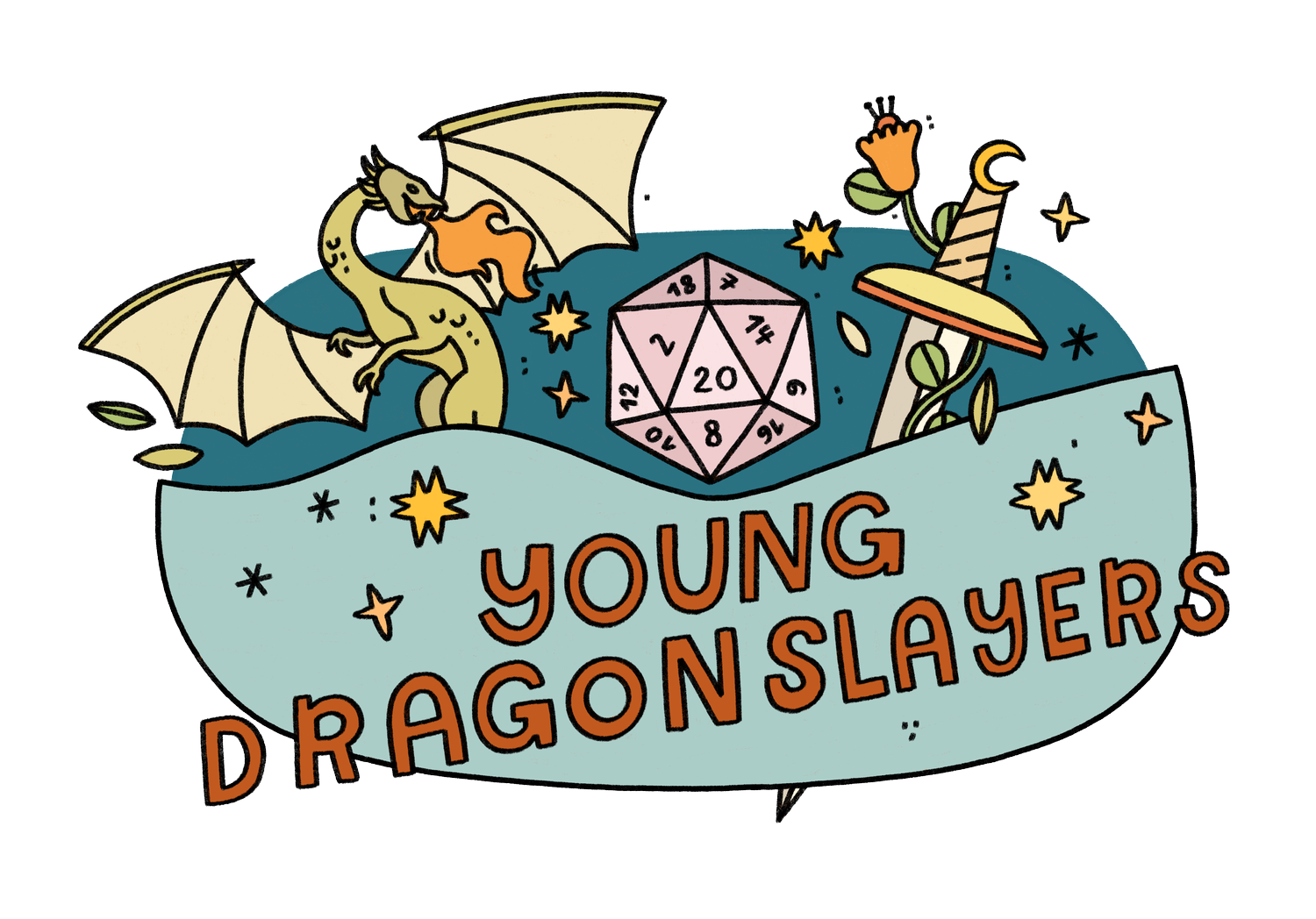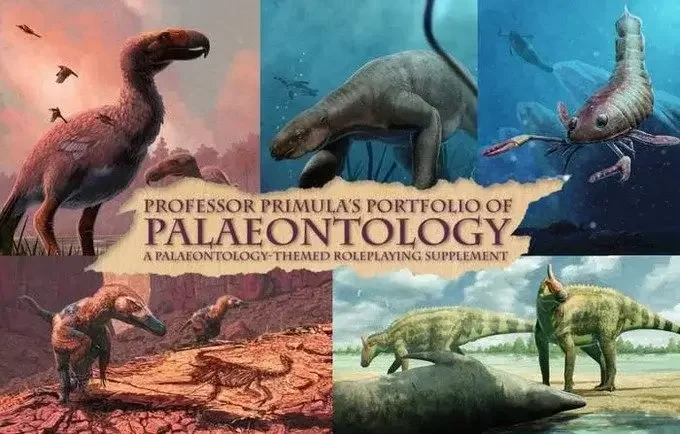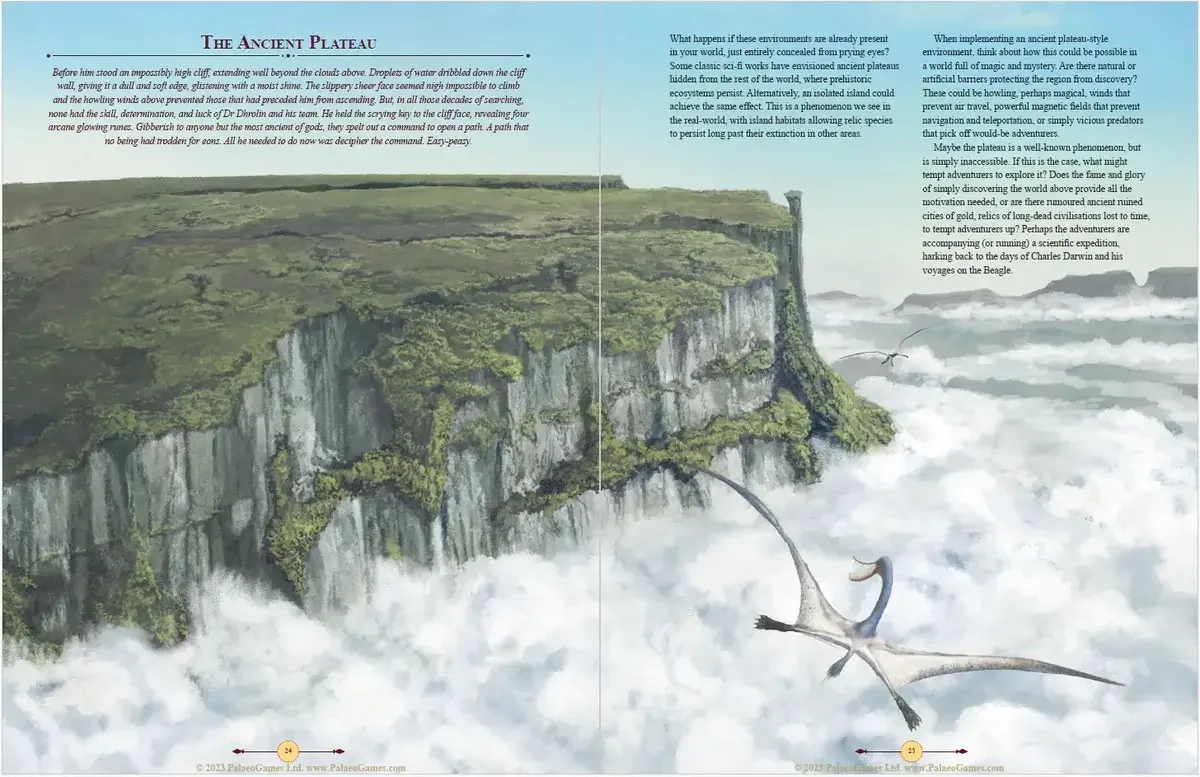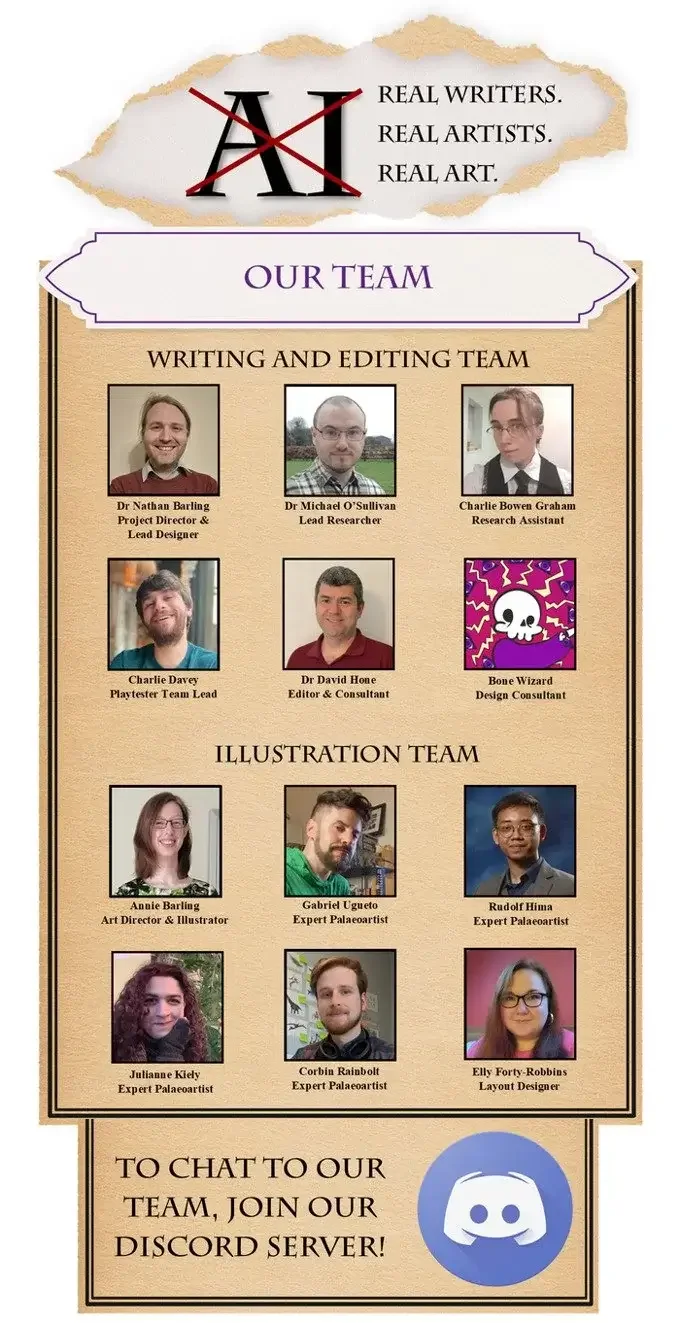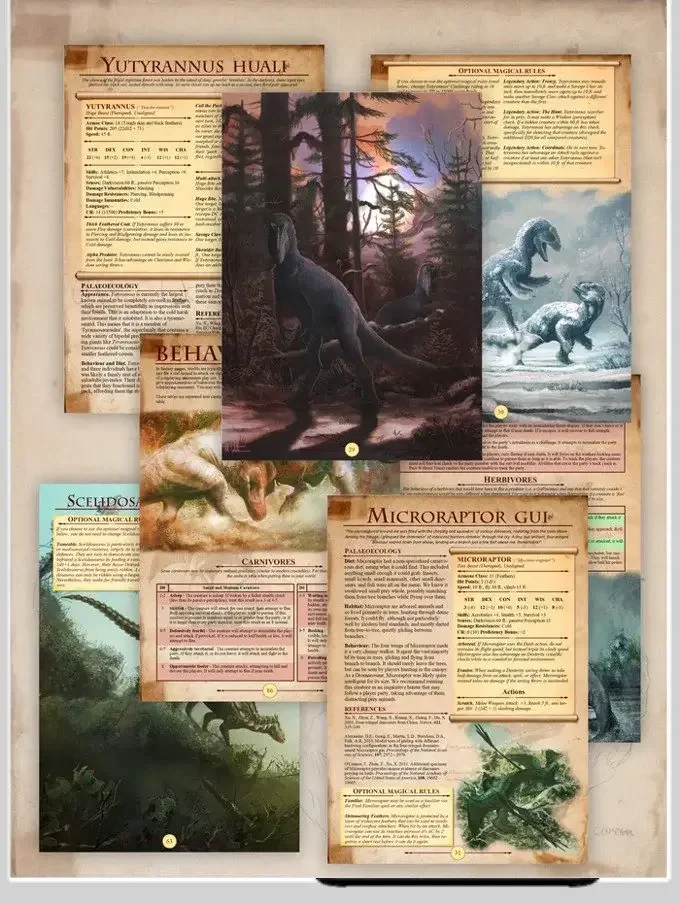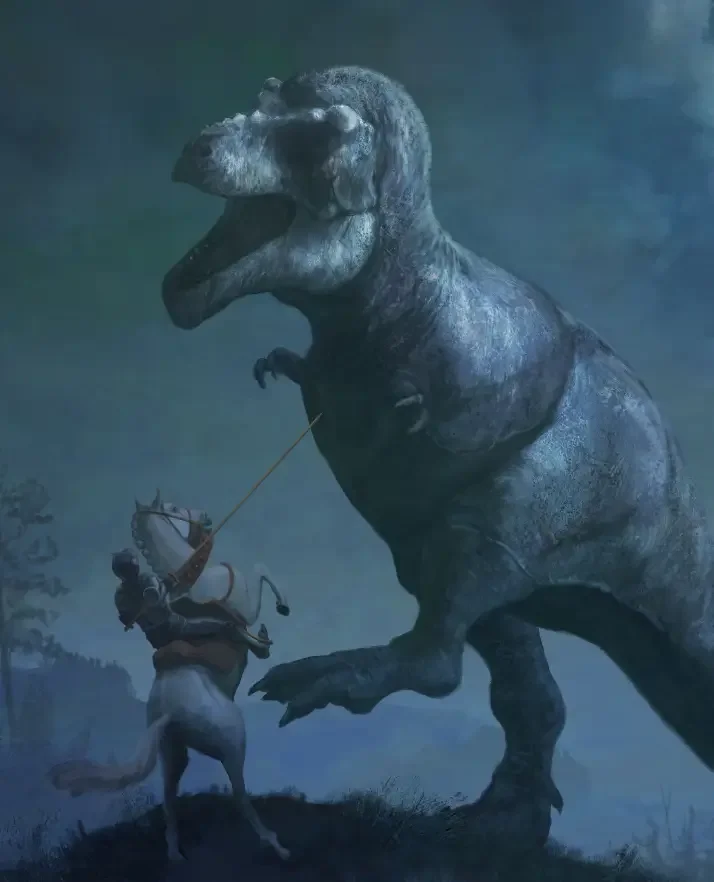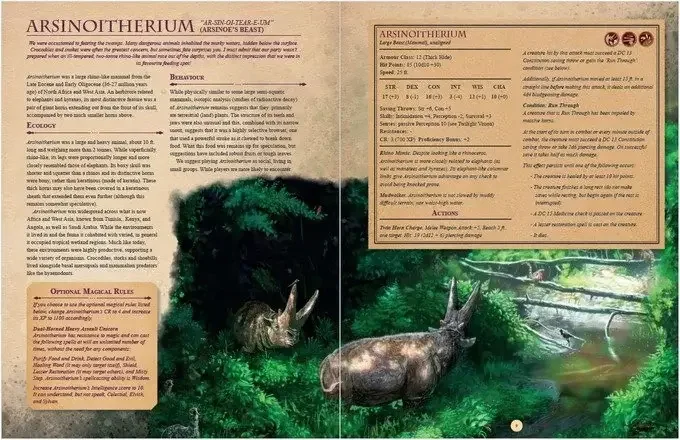Add Scientifically Accurate Dinosaurs to Your D&D Campaign
Going toe-to-toe with wild creatures is a staple of Dungeons & Dragons. And while the classic D&D creatures – like beholders, owlbears, and gelatinous cubes – are awesome, there's something more realistic and uniquely exciting about facing fearsome creatures from our world. And dinosaurs are, quite possibly, the coolest creatures to walk the Earth. While dinosaurs do exist in D&D, the dinosaur D&D stats, while cool in concept, don't have the depth of real dinosaurs (and, as we discovered, are sometimes straight-up inaccurate)! But a team of palaeontology research scientists set out to fix that; we’re here to tell you about their efforts.
Note: Though we are a US-based organization, we have opted to use the UK spelling of “palaeontology” throughout this article for consistency with the UK-based PalaeoGames.
How To Make A Dinosaurs D&D Book?
Their team is composed of palaeontology research scientists, palaeo-artists, and game designers who love tabletop RPGs like Dungeons & Dragons. They set out to create scientifically-accurate palaeontological content for games; so far, they’ve created Dr. Dhrolin’s Dictionary of Dinosaurs and Professor Primula's Portfolio of Palaeontology. We got to chat with Linda Zayas-Palmer, a freelance writer and game designer who worked on Dr. Dhrolin’s Dictionary. “One of the things I find really appealing about [PalaeoGames] is their commitment to using the game as…a way to educate and excite people about history,” said Linda. To fully immerse players in palaeontology, the PalaeoGames books give gamified versions of everything from plant species to non-dinosaur animals to interactive rules for each of several environments from prehistoric eras (swamp, ocean, desert, jungle, lake, plains, mountains, tundra, coastal, island, and forest). The interactive medium of tabletop RPGs is a great way to engage people with real-world science and history; resources like this can further empower these games to educate and inspire.
This D&D Dinosaurs Guide Uses Real Science!
We loved learning about the ways the game designers on Book of Extinction brought in scientific consultants to ensure accuracy in their book. But we have to confess that, in this area, PalaeoGames has them beat; instead of game designers with science consultants, they’re scientists with game-design consultants! “I got the email from Dr. Nathan Barling, the palaeontologist," said Linda. She was surprised to hear that he needed 6 months to get her the information about each dinosaur…that is, until she got the statblock drafts – with multiple papers cited in each! “They want to make sure they have high fidelity. They're looking at the papers. They may be even doing follow-ups with some of the experts in the field….[Dr. Barling] would find an expert in a particular creature and ask them which of these types of game rules might work.” All of the environments, plants, and creatures (dinosaurs and otherwise!) in the book are based on fossil discoveries and published data that these palaeontologists have combed through (or even contributed to themselves)! “We're having this whole conversation about the evolution of echolocation and electroreception systems and what the fossil record shows,” said Linda.
Making Each Dinosaur D&D Build
Clearly, it was a significant undertaking to gather, cite, and summarize all of this information. But it was another entirely to convert each creature’s physical abilities, behaviors, and patterns into the structure of a Dungeons & Dragons dinosaur stat block. Rather than the typical “Natural Armor” feature accompanying many D&D armor classes, each creature in PalaeoGames’ books has specific descriptions of their defense types, including scales, features, and even hair. They also broke away from the design philosophy of Wizards of the Coast. On a typical D&D statblock, the bonuses to saving throws, skill checks, and attack rolls are calculated by adding the ability score modifier and, if relevant, a creature’s proficiency bonus. “We find the standard ability score and proficiency-bonus system too limiting,” explains PalaeoGames in Dr. Dhrolin’s Dictionary of Dinosaurs, “For example, we may decide that a species of raptor should have a high Survival skill, but don’t want to over-inflate it’s [sic] Wisdom ability score to allow this and just giving it expertise doesn't quite match our intent... so we give it a flat bonus to Survival instead, based on how good it should be at this skill relative to other animals in the book.” This gives each dinosaur D&D build a more accurate picture of their abilities. “There's an emphasis on using the actual way that these creatures lived and hunted and behaved as a strong inspiration. You want things to be accurate to the way that they would have been,” said Linda. Of course, not every real-world aspect of these dinosaurs translated into the game. For example, speed in D&D is a set number of feet a creature can move on each turn. If a dinosaur is significantly faster than the players, they could easily run away every time they were encountered. “Animals would have run away a lot more often than they do in tabletop RPGs!” said Linda.
A Scientifically Accurate D&D 5e T Rex
The natural question on everyone’s minds is this: how did these palaeontologists create a T Rex D&D statblock? Well, they followed the same steps they did for every other creature in their books. They started with a piece of art created by expert palaeontologists. Then, they build the dinosaur’s D&D 5e statblock. PalaeoGames’ T Rex has incredible strength and constitution scores alongside abilities like Power Over Speed, Territorial Titan, and When Dinosaurs Ruled the Earth – all descriptions of the behaviors and abilities of the real-world T Rex! Its attacks are the same; it can bite with its jaws, whip with its tail, bash with its head, and frighten with its bellow.
PalaeoGames’ books also share palaeontological information about each creature; for the T Rex, they discuss how large the T Rex – and other giant predators – actually were, including the statistical calculations of the largest Tyrannosaurs, the calculations of a T Rex lifespan, and the discoveries of T Rexes found in the fossil record. (The references, in case you're curious, include The Science of Nature, Proceedings of the Royal Society of London Biological Sciences, Society of Vertebrate Paleontology 82nd Annual Meeting Program Guide, and The Anatomical Record). As a cherry on top of each creature, they also added some optional rules for magical campaigns. For the T Rex, they wrote the abilities Imparted Speech and Wise Old Beast, which give it a boost to its intelligence score, advantage on wisdom saving throws, and two languages.
These Dinosaur D&D Stats Have More Than Attacks
As you can see from the T-Rex entry in Dr. Dhrolin’s Dictionary of Dinosaurs, there’s more to dinosaurs than a list of actions and a set of damage dice to throw. “They really try to bring you into the whole experience,” said Linda. As part of this endeavor, PalaeoGames crafted a whole section of tables to emulate different dinosaurs’ behavior and rules for taming and domesticating dinosaurs. Say you rolled a 6 on a behavior table. Then you might find an aggressively territorial small carnivore, an ambush carnivore is patrolling its territory, an irritable large carnivore, a large herbivore making a threat display, an armored herbivore charging the party, or a small carnivore ready to fight to the death. They’ve also created 120 potential mutations for their prehistoric creatures. These mutations are inspired by real-world evolutionary biology but have a Dungeons & Dragons twist, like letting your dinosaurs mutate sacs to hold electrical charge, a bulbous head to emit a sonic scream, and even color-changing skin to turn invisible!
Play Your Own Dinosaur D&D Adventure
If all of this leaves you itching to create your own character and jump into the prehistoric world of dinosaurs, we’ve got you covered. We run online games of Dungeons & Dragons for tweens and teens. Our professional Dungeon Masters who use digital tools, their own creativity, and awesome supplements like these to craft the perfect campaign for their players’ interest, whether it’s palaeontology or Deltarune (or both)! We’re all experienced in working with young people – with backgrounds in education, therapy, and more – and we love getting to come up with fun, unique adventures for our players to enjoy. Learn more about our games below, and check out palaeoGames’ awesome books while you’re at it!
